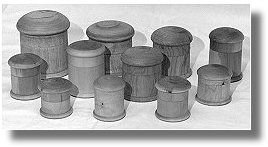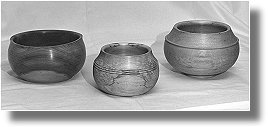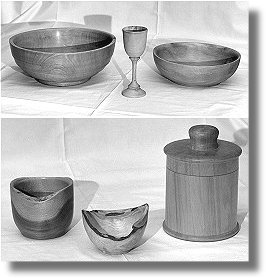woodturning
To work with wood and especially woodturning is my main hobby during the winter. To be able to create objects, smooth to touch and nice to look at but still made to be used, is an important way for me to get away from stress and daily trivialities. I'm mostly self-taught but have taken some turning courses and attended meetings. I've also visited some of the old masters like Bengt Gustavsson, meetings that have been extremely fruitful and given me many unforgettable memories.

Woodturning has really old traditions in Scandinavia, and many old objects are saved at different museums.
The layouts were mostly simple and clean, which I also prefer, so I try not to overwork my turneries. My favorite objects
are lidded boxes and bowls with different shapes. Apart from that, I use to make a lot of candle sticks,
knobs and I guess most things that are round and might be turned.

I prefer to turn from green wood and try to use the leafy trees that grows up here in the north, like birch, sallow, mountain ash,
bird cherry, aspen and even the soft alder. All have beautiful wood, some with really nice colors,
and they all gives nice surfaces when turned.
There are also many things I turn from seasoned wood, like candle sticks and a lot of different knobs.
As I'm building many fishing rods, all of the handles and reel seats are made in the lathe.

In my shop you'll find, amongst others, a Lundgren lathe, which is the one I usually work with,
and I'm mainly using chisels and gouges almost equally.
I have collected a few really old irons with fantastic alloys and hardenings. With some patience while sharpening, I can
obtain enormously sharp edges on these tools, which really is important as I'm only cutting and not scarping.
When cutting, the sharpness is of outmost importance for both result and security when turning,
and with sharp edges you don't need any sanding which means that you'll keep the nice pattern from the tools in the surface.

Most of my turneries are treated with a standard mixture of linseed oil and balsam turpentine.
The oils gives a nice and really smooth surface, excellent color to the wood and smells very good. After re-oiling,
the wood obtains a nice strong patina, and the treatment with oil
almost makes them resistant to water so they will withstand ordinary use. Objects that will be used to contain food-stuff
are treated with paraffin oil, that does not smell or taste, but unfortunately does not give the same nice color to the wood.
I do not use any type of clear or colored lacquer at all, but occasionally a mixture of oil and pigments to stain the wood. Many times
staining with natural colors might bring out more life in the wood but I always try not to distort the true natural colors.
top of page